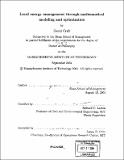Local energy management through mathematical modeling and optimization
Author(s)
Craft David (David Loren), 1973-
DownloadFull printable version (10.79Mb)
Other Contributors
Massachusetts Institute of Technology. Operations Research Center.
Advisor
Richard C. Larson.
Terms of use
Metadata
Show full item recordAbstract
(cont.) Extensions to the core TOTEM model include a demand charge model, used for making daily optimal control decisions when the electric bill includes a charge based on the monthly maximum power draw. The problem of heating, ventilation, and air conditioning (HVAC) control is treated separately since it strongly violates TOTEM's linearity assumptions. Nonetheless, we describe a solution approach to the HVAC problem which operates in conjunction with TOTEM. We also provide an analysis of storage suitability in stochastic supply and demand networks. The node-based approach lends itself well to a software system that uses a drag- and-drop graphical network creation tool. We present a graphical user interface, the XML data representation, and the communication links to and from optimization software. We develop an extensive yet tractable framework for analyzing and optimally controlling local energy networks. A local energy network is any set of generation, storage, and end-use devices existing to provide energy fulfillment to a building, a group of jointly operated buildings, or a village power system. The software developed is called TOTEM for Total Energy Management, and provides hourly (or sub-hourly) control over the flows in such energy networks. TOTEM manages multiple energy flows such as electricity, chilled water, heat, and steam together, since such energies are often coupled, particularly for networks containing cogeneration turbines (which produce electricity and steam) and absorption chillers (which use steam for driving refrigeration turbines). Due to the large number of interconnected devices in such networks, the model is kept as a linear mixed integer program, able to be solved rapidly with off-the-shelf mathematical optimization packages. Certain nonlinearities, for example input-output relationships for generators, are handled in this linear framework with piecewise linear approximations. Modeling flexibility is achieved by taking a node-centric approach. Each device in the network is represented as a node, and depending on each node's set membership, proper constraint and objective equations are written. Given the network, TOTEM uses hourly electricity and fuel pricing, weather, and demand projections to determine the optimal operating and scheduling strategy for the day, in both deterministic and stochastic settings. MIT's cogeneration plant is used as a case study, with other examples throughout the thesis demonstrate the use of TOTEM for assessing and controlling renewable resources, storage options, and
Description
Thesis (Ph. D.)--Massachusetts Institute of Technology, Sloan School of Management, Operations Research Center, 2004. Includes bibliographical references (p. 217-223).
Date issued
2004Department
Massachusetts Institute of Technology. Operations Research Center; Sloan School of ManagementPublisher
Massachusetts Institute of Technology
Keywords
Operations Research Center.